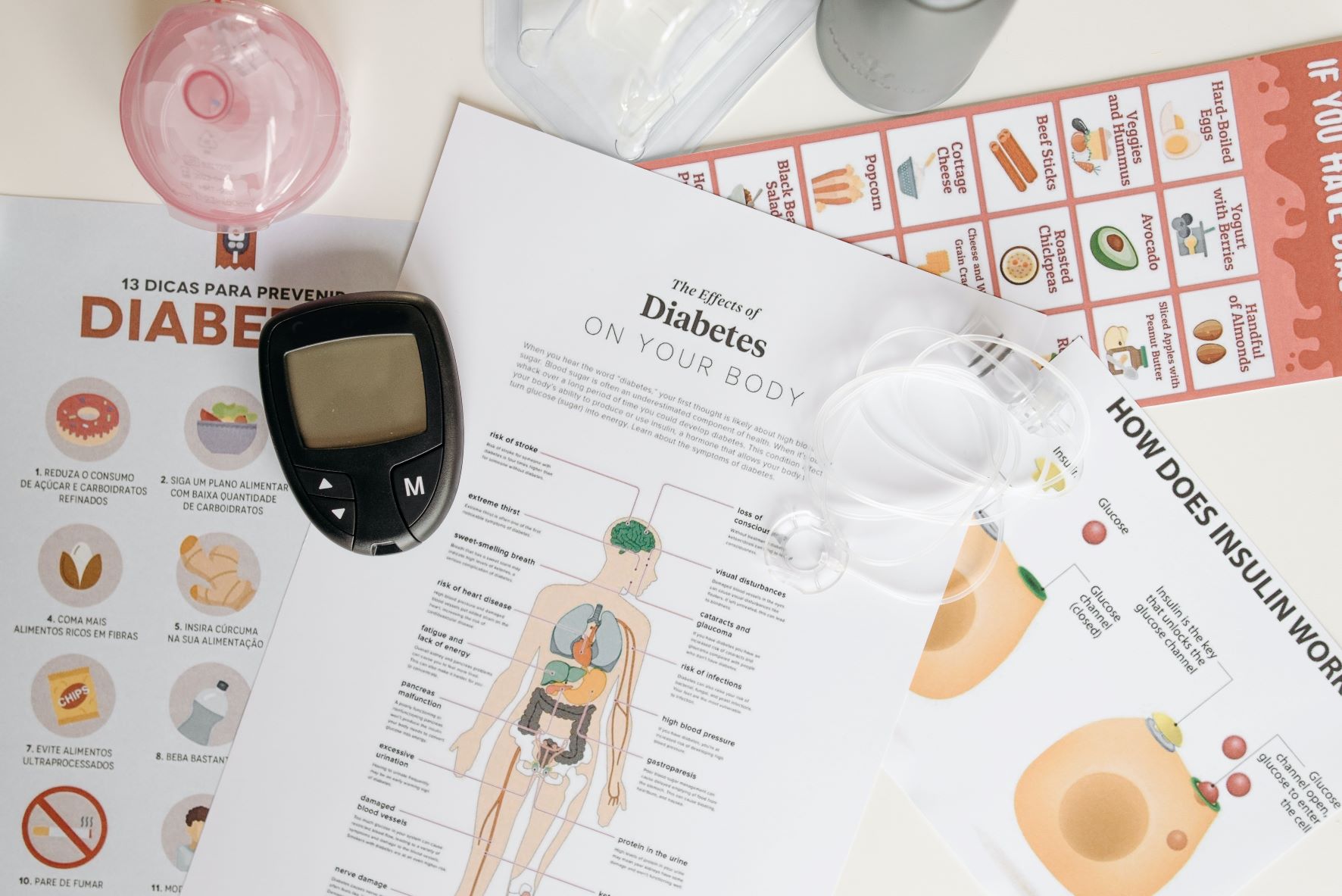Diabetes is a chronic disease that occurs when the pancreas is no longer able to make insulin, or when the body cannot make good use of the insulin it produces.
Insulin is a hormone made by the pancreas, that acts like a key to let glucose from the food we eat pass from the blood stream into the cells in the body to produce energy. All carbohydrate foods are broken down into glucose in the blood. Insulin helps glucose get into the cells.
Not being able to produce insulin or use it effectively leads to raised glucose levels in the blood (known as hyperglycaemia). Over the long-term high glucose levels are associated with damage to the body and failure of various organs and tissues.
There are three main types of diabetes: Type 1, Type 2 and Gestational
A blue circle is the universal symbol for diabetes (introduced in 2006) (IDF)
Type 1 Diabetes
- Around 10% of all people with diabetes have type 1 diabetes.
- Usually develops in children or young adults.
- Having a family member with type 1 diabetes slightly increases the risk of developing the disease.
- Environmental factors and exposure to some viral infections have also been linked
- to the risk of developing type 1 diabetes.
Common symptoms of Type 1 Diabetes
- Abnormal thirst and dry mouth
- Sudden weight loss
- Frequent urination
- Lack of energy, tiredness
- Constant hunger
- Blurred vision
- Bedwetting
Management of Type 1 Diabetes
- People with type 1 diabetes require daily insulin treatment, regular blood glucose
monitoring and a healthy lifestyle to manage their condition effectively. - Healthy nutrition
- Healthy nutrition — knowing what and when to eat — is an important part of
diabetes management as different foods affect blood glucose levels differently. - A healthy diet for all people with diabetes includes reducing the amount of calories
if they are overweight, replacing saturated fats (eg. cream, cheese, butter)
with unsaturated fats (eg. avocado, nuts, olive and vegetable oils), eating dietary
fibre (eg. fruit, vegetables, whole grains), and avoiding tobacco use, excessive
alcohol and added sugar.
- Healthy nutrition — knowing what and when to eat — is an important part of
- Physical activity
- Regular physical activity is essential to help keep blood glucose levels under
control. It is most effective when it includes a combination of both aerobic (eg.
jogging, swimming, cycling) exercise and resistance training, as well as reducing
the amount of time spent being inactive.
- Regular physical activity is essential to help keep blood glucose levels under
Type 2 Diabetes
The most common type of diabetes, accounting for around 90% of all diabetes cases. The most commonly diagnosed in older adults, but is increasingly seen in children, adolescents and younger adults due to rising levels of obesity, physical inactivity and poor diet.
It is generally characterized by insulin resistance, where the body does not fully respond to insulin. Because insulin cannot work properly, blood glucose levels keep rising, releasing more insulin. For some people with type 2 diabetes this can eventually exhaust the pancreas, resulting in the body producing less and less insulin, causing even higher blood sugar levels (hyperglycaemia).
Several risk factors have been associated with Type 2 Diabetes and include:
- Family history of diabetes
- Overweight
- Unhealthy diet
- Physical inactivity
- Increasing age
- High blood pressure
- Ethnicity
- Impaired glucose tolerance – a category of higher than normal blood glucose, but below the threshold for diagnosing diabetes.
- History of gestational diabetes
- Poor nutrition during pregnancy
Excessive thirst and dry mouth
Frequent urination
Lack of energy, tiredness
Slow healing wounds
Recurrent infections in the skin
Blurred vision
Tingling or numbness in hands and feet.
Symptoms of Type 2 Diabetes
The symptoms of Type 2 Diabetes are similar to those of Type 1 Diabetes and include:
Prevention of Type 2 Diabetes
There are a number of factors that influence the development of type 2 diabetes. The
most influential are lifestyle behaviours commonly associated with urbanization.
Research indicates that a majority of cases of type 2 diabetes could be prevented
through healthy diet and regular physical activity. A healthy diet includes reducing the
amount of calories if you are overweight, replacing saturated fats (eg. cream, cheese,
butter) with unsaturated fats (eg. avocado, nuts, olive and vegetable oils), eating dietary
fibre (eg. fruit, vegetables, whole grains), and avoiding tobacco use, excessive alcohol
and added sugar.
Regular physical activity is essential to help keep blood glucose levels under control. It
is most effective when it includes a combination of both aerobic (eg. jogging, swimming,
cycling) exercise and resistance training, as well as reducing the amount of time spent
being inactive.
Prevalence of Diabetes
- Over the past decade, the prevalence of diabetes has risen faster in low and middle-income countries than in high-income countries (Shiferaw et al., 2020)
- 79% of adults with diabetes were living in low and middle-income countries.
- In 2015 the prevalence of diabetes among adults in Sri Lanka is 8.5%.
- In Sri Lanka the prevalence of diabetes is 10.7% between the age of 20 – 79 yrs – in 2019 (IDF)
- The prevalence of diabetes between the age of 20 – 79 yrs – 2019 (IDF)
- Lower middle income countries – 9.2%
- Low income countries – 9.0%
- Middle income countries – 9.2%
- High income countries – 7.9%
References
- International Diabetic Federation (IDF)
- Ubayawansa, D.H.B., Abeysekara, W.Y.M., Kumara, M.M.A.J.(2016) Major Lower Limb Amputations: Experience of a Tertiary Care Hospital in Sri Lanka: J Coll Physicians Surg Pak, 26(7), pp. 620-2
- Varma, P., Stineman, M.G., Dillingham, T.R.(2014) Epidermiology of limb loss: Phys Med Rehabil Clin N Am, 25(1), pp.1-8
- Shiferaw, W.S., Akalu, T.Y., Work, Y., Aynalem., Y.A.(2020) Prevalence of diabetic peripheral neuropathy in Africa: a systematic review and meta-analysis: BMC Endocr Disord, 20(1,) p.49
- https://data.worldbank.org
- https://www.ips.lk


